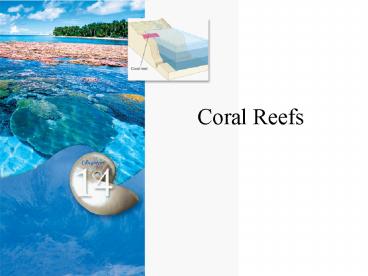Coral Reefs - PowerPoint PPT Presentation
1 / 34
Title: Coral Reefs
1
Coral Reefs
2
Introduction
- Calcium carbonate (CaCO3) anyone??
- Limestone is left over when animals grow and die.
- This carbon containing molecule is the basis for
coral formation. - As we will see, coral production exhibits huge
impacts on ecosystem diversity and success.
3
- Requirements for Reef Formation
- High Light Levels
- High Water Transparency
- Water Temperatures gt 20C (68F)
- Low Nutrient Waters
- Hard Substrate for Attachment
- Strong water movement
4
Coral Types
- Hard (Stony) Corals build the reef by extracting
calcium carbonate from the ocean water - They Create a home in which primary producers can
live - They create a diverse 3-dimensional space in
which many other organisms can find homes
5
What is Coral?? Animal, Vegetable, Mineral?
Rem Coral are actually a special group of
cnidarians, the same family as jellyfish!!
6
Hermatypic vs. Non-Hermatypic Corals
- Hermatypic Corals (a) Corals that form large
colonies called reefs. - Non-Hermatypic Corals (b) Corals that are
solitary or form small colonies.
a. brain coral (Diploria)
b. Mushroom coral (Fungia)
7
Coral larva are callled planula, since they dont
like soft sea floors, they often metamorphose
into a polyp which establishes a founder colony
in new location.Rem Medusas are the mobile
polyp.
Boulder coral Montastrea cavernosa
8
Coral remain closely connected.
Zooxanthellae, single- celled photosynthetic
algaework within the coral tohelp feed it
through photosynthesis.As a result of this
symbioticrelationship, many coralsdont need to
seek food.
9
Mutualism Between Corals and Zooxanthellae
- Coral Polyp
- provides a home for the zooxanthellae
- provides nitrates and phosphates
- Gives off CO2
10
Here is a good example of a live coral.
11
Obviously, the one on the left need help!!
12
Coral take on many shapes!!
13
Reefs grow when calciumcontaining sediments are
deposited in spaces between coral.As
encrusting coraline algae glues the sediments
together,new live rock is formed.
14
Once this Halimeda dies, 95 of what remains will
be real estate for new coral colonies.
15
Coral exhibit limited range in growth patterns.
16
Without proper light and temperature,coral dies
(bleaches).It only takes 1-2 degrees in some
cases.How does global warming effect this
trend?
17
From this
18
To this.
Temperature increases and competition from red
algae have killed much of this coral reef.
19
Coral Reefs Have High Primary Productivity
- Coral Reef primary production ranges from 1500
to 3700 g of C/m2/yr. - This makes Coral Reefs one of the most productive
communities on earth. - Rapid Nutrient Cycling between Zooxanthellae and
corals may be partially responsible for this.
20
Fringe Reefs Diving anyone??
21
Growth on reefs are often limited by tidal action.
22
Disease is another major factor limiting growth.
Here is an example of elkhorn coral (Acropora
palmata) infested by white band disease.
23
Barrier Reefs
24
An excellent example of a Pacific barrier reef.
25
Barrier reef structure can be influenced by spur
and groove formations such as these.
26
The Great Barrier Reef
27
Atoll Reefs Volcanic Left-overs!
28
Atoll Reef Fulanga
29
Atoll Formation Step by step
30
Reef Ecology Edge effect again
31
Food Webs Same concept, more complexity
32
Coral Fights??Yes!Just like other
animals competing for space, coral attack each
other if they come into close contact.Usually
they just over grow one another, but some
actually poison the others out.
33
Again, we see that real estate is at a premium
with these soft corals. Soft corals are fast
growers, making them excellent competetors.
34
Harmony? Not really, most animals on reefs
compete daily for everything, from food to mating
opportunities.































